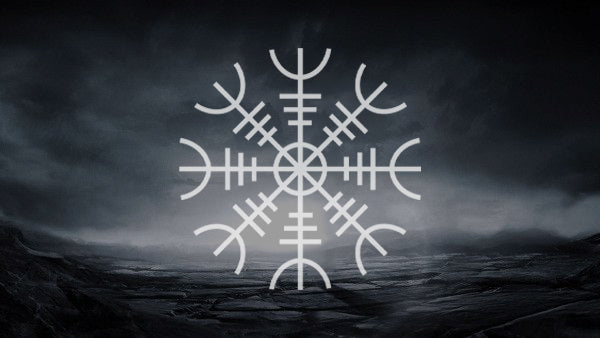The Helm of Awe
The term Ægishjálmr has a specific meaning that applies to this symbol and its origin. Ægishjálmr or Ægishelm is an Anglo-Saxon word that means 'helm of awe'. The term refers to the protection provided by the Helm Odin is said to have given his people by wearing it during battle. In another sense, the term is alluding to the mythical symbol's ability to strike fear in people's hearts. This can be seen in the way that ancient Scandinavian warriors would use the Helm of Awe on their shields. Each time an enemy ran at them with sword raised for a strike, he would see a flash of light from the shield and second guess his attack.
This Norse symbol is one that provides strength and protection—not only from physical threats such as war or diseases but also against threats to your mental health, such as depression and fear. The symbol was worn by the dragon Fafnir, to provide him with invincibility during battle. Similarly, warriors would bear the mark between their eyebrows as they believed it would do the same for them.
The Aegishjalmur is mentioned in the Poetic Edda regarding Fafnir:
“The Helm of Awe
I wore before the sons of men
In defense of my treasure;
Amongst all, I alone was strong,
I thought to myself,
For I found no power a match for my own.”
The belief goes that the circle in the center represents the protection to those wearing the symbol, but others believe that it represents one’s soul. All in all, the vision of the symbol itself is so compelling that it inspires awe and fear without even considering the meaning.
When did the Helm of Awe originate?
Because the earliest examples of the Helm of Awe are from the 18th century, historians have no way to know how long it might have been in existence before that. The symbol first appears in an Icelandic manuscript from 1670, but there is a catch: Before this time, there is no evidence of its use. In fact, prior to 1670, there isn't even any evidence that Icelanders were aware of the symbol's existence. That doesn't necessarily mean that it didn't exist before then; it just means that no one had written about it or used it to decorate anything before that date.
The first other appearance of the symbol is in 1869 on a stone in a church in Fåberg, Norway. It was created by the same man who carved a swastika into the Laxdæla Stone in Iceland. Like other Viking Age carvings, this stone was later quarried for building material and moved to another location. Once again, we don't know whether this carving dates back to an earlier time or not; we just have some circumstantial evidence that it could be an old symbol (the swastika is known to be much older than this example). We can only say with any certainty that at some point between 1670
The Helm of Awe and the Runes
While the Helm of Awe is a symbol used by the Vikings that is also featured prominently in Anglo-Saxon magic, the connection with the runes is particularly apt, because a number of the shapes that comprise the Helm have the same forms as certain runes. Given the significance of the runes in all of Germanic magic, it is exceedingly improbable that this correlation was a coincidence.
he Helm appears to have Z-runes as its "arms. This rune's original name is unclear, however it is currently frequently referred to as "Algiz. This rune was a good candidate for the Helm of Awe since its significance was closely related to defense and triumphing over one's adversaries.
It's possible that the "spikes" that cross the "arms" at an angle are Isa runes.. While the meaning of this rune is more or less unknown due to confusing and contradictory information supplied by primary sources, it seems reasonable to speculate that since “Isa” means “ice,” its inclusion in the Helm of Awe could have imparted some sort of magical power related to ice.
Other Religions' Uses of the Helm of Awe
The Helm of Awe is associated with a variety of different beliefs, such as Triquetra and the Valknut. Another religion it is associated with is Asatru. This religion is a modern variation of the ancient Norse beliefs. Being a part of this religion means living by the Nine Virtues of Asatru, namely Courage, Truth, Honor, Fidelity, Hospitality, Discipline, Industriousness, Self-Reliance, and Perseverance.
The symbol of the Aegishjalmur bears a resemblance to a couple of other symbols from different origins. One of these symbols is the dharma wheel found in Buddhism, which is said to be the path to enlightenment. While this may well be a coincidence, it is a fascinating connection, because there is evidence that proves that Norse people once migrated out of the Indian subcontinent.
While there are many theories and beliefs surrounding the Helm of Awe, it is clear that it is a Viking symbol of power that people believe will provide them with protection and strength in whatever ballet they may be facing.
Conclusion
There are many stories that depict various meanings of the Helm of Awe. Yet no matter the outcome, one thing remains certain: the Helm has proven to have striking visual effects on people. It's almost as if the wearer of this symbol can conjure up an aura of glittering light for a moment that blinds onlookers and makes them cautious about approaching the wearer any further. Perhaps the warrior would never see the dread in his enemy's eyes, but the Helm could sure give that enemy a pain in theirs.





Hinterlassen Sie einen Kommentar